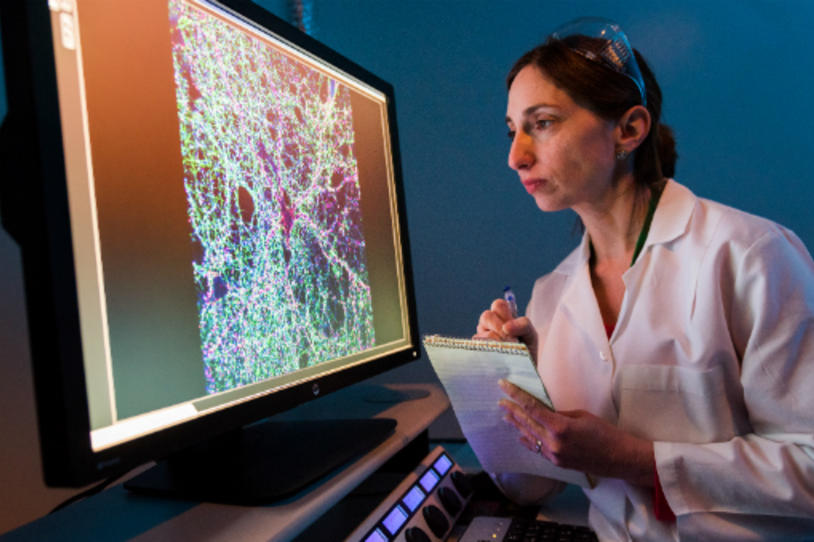
Deep brain stimulation (DBS) is an effective treatment for many people with Parkinson’s motor symptoms and medication-related symptom fluctuation. But, like all currently available medications and surgical therapies, DBS often is not beneficial for freezing of gait (an interruption of walking in which a person temporarily cannot move) — especially when freezing happens during “on” times, periods in which medication is working well for other symptoms.
In a study funded by The Michael J. Fox Foundation (MJFF) in the “Improved Neuromodulation Approaches for Parkinson's Disease” research program — and recently published in Frontiers in Human Neuroscience — researchers examined whether a novel method of DBS, using a new device in a different brain area, could ease freezing. Unfortunately, the study revealed inconsistent benefit among participants (some showing decreased freezing; others not) and a high rate of side effects.
The scientists in the trial were organized into three collaborating teams at the University of Florida Health that focused on brain signals of walking and the DBS device approach led by Ayse Gunduz, PhD, and Rene Molina, PhD; measures of gait headed by Christopher Hass, PhD; and DBS surgery and device programming headed by Michael Okun, MD, and Kelly Foote, MD. The study included five volunteers with Parkinson’s disease who experienced freezing of gait when “on.” Each underwent DBS in two different brain areas: the GPi (globus pallidus interna), a target scientifically proven to decrease Parkinson’s motor symptoms, as well as the PPN (pedunculopontine nucleus), a brain area under investigation for possible benefits on freezing and walking.
In traditional DBS, one brain wire, or lead, typically is placed in the GPi or STN (subthalamic nucleus) on each side of the brain, for a total of two wires. These leads are connected to a device in the chest which is programmed to deliver continuous electrical stimulation to ease symptoms. (Read more about DBS.) For this study, participants had one lead in both the GPi and PPN on each side of the brain for a total of four leads. The GPi leads were connected to a standard DBS stimulator and the PPN leads were connected to a separate, novel “closed loop” stimulator. Closed-loop, or adaptive, DBS currently is in clinical testing to evaluate its potential to monitor brain signals and to deliver stimulation on demand, such as during freezing, rather than continuously as standard DBS devices do.
Six months after the procedure, three of the five study participants had a 40 percent improvement in freezing of gait. The two others had infections requiring device removal. Researchers concluded that recruitment was feasible (people volunteered to participate in an invasive surgical trial), but that safety was suboptimal, and the benefits varied. The researchers also noted that volunteers’ symptoms progressed, so that even if freezing improved, balance problems could potentially cancel out those benefits.
Negative trial results are always disappointing. But they are an important step in learning what does and doesn’t work to develop better (and safe) therapies, particularly for symptoms such as “on” time freezing that don’t yet have sufficient treatments. About this study, co-author Michael Okun, MD, Adelaide Lackner Professor and Chair of Neurology and Executive Director of the Norman Fixel Institute for Neurological Diseases at the University of Florida said, “Though this is not going to be the ultimate approach for the future, we learned a lot about closed-loop DBS and the physiology of freezing, which has moved the field forward. It is critical we ask — and work to answer — the challenging questions about what underpins symptoms and to continue to innovate solutions. We need to keep working. Medication resistant symptoms such as freezing of gait, walking and balance issues have a huge effect on quality of life and are unmet needs.”
These results will inform additional research in DBS, much of which already is ongoing. Another MJFF-funded trial at the University of California, San Francisco is recording individuals’ brain activity and delivering DBS stimulation during different walking phases to understand the signals that control walking and to ultimately ease gait problems in people living with Parkinson’s. And MJFF’s DBS registry is collecting data on people who undergo DBS — where in the brain are the leads, when in the course of disease is DBS applied, what device and settings are used as well as other critically important information. This will deepen our understanding of the optimal timing and delivery of this therapy.
For the most up-to-date information about ongoing DBS trials, visit foxtrialfinder.org.
For more on DBS, visit our webpage and listen to a webinar. And stay tuned to our website for new resources on this topic in the coming months.
